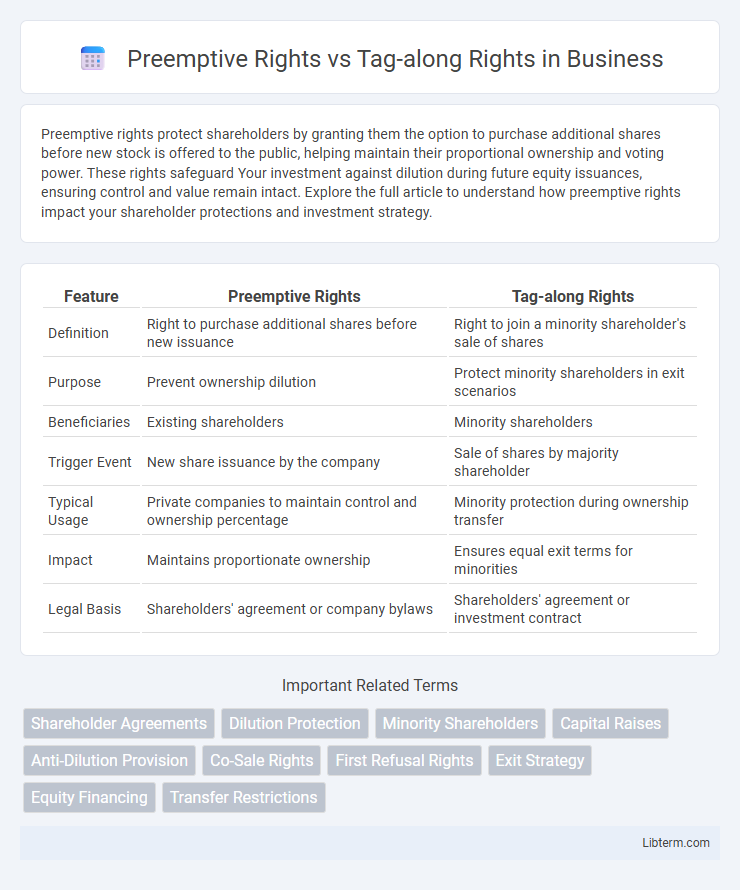Preemptive rights protect shareholders by granting them the option to purchase additional shares before new stock is offered to the public, helping maintain their proportional ownership and voting power. These rights safeguard Your investment against dilution during future equity issuances, ensuring control and value remain intact. Explore the full article to understand how preemptive rights impact your shareholder protections and investment strategy.
Table of Comparison
| Feature | Preemptive Rights | Tag-along Rights |
|---|---|---|
| Definition | Right to purchase additional shares before new issuance | Right to join a minority shareholder's sale of shares |
| Purpose | Prevent ownership dilution | Protect minority shareholders in exit scenarios |
| Beneficiaries | Existing shareholders | Minority shareholders |
| Trigger Event | New share issuance by the company | Sale of shares by majority shareholder |
| Typical Usage | Private companies to maintain control and ownership percentage | Minority protection during ownership transfer |
| Impact | Maintains proportionate ownership | Ensures equal exit terms for minorities |
| Legal Basis | Shareholders' agreement or company bylaws | Shareholders' agreement or investment contract |
Understanding Preemptive Rights
Preemptive rights grant existing shareholders the opportunity to purchase additional shares before the company offers them to new investors, protecting their ownership percentage from dilution. These rights are essential in maintaining control and value in a company, especially during new funding rounds or equity issuances. Understanding preemptive rights helps shareholders safeguard their investment and influence in a growing business.
What Are Tag-along Rights?
Tag-along rights protect minority shareholders by allowing them to join a majority shareholder's sale of equity on the same terms, ensuring they receive equal treatment and fair exit opportunities. These rights prevent majority shareholders from selling shares without offering minority shareholders the chance to sell their shares under identical conditions. Tag-along rights are essential in maintaining minority shareholder protection and enhancing investor confidence in private equity transactions.
Key Differences Between Preemptive and Tag-along Rights
Preemptive rights allow existing shareholders to maintain their proportional ownership by purchasing additional shares before new investors, preventing dilution. Tag-along rights protect minority shareholders by enabling them to sell their shares alongside majority shareholders during a sale, ensuring equitable exit opportunities. The key difference lies in preemptive rights focusing on ownership preservation, while tag-along rights focus on exit protection during ownership changes.
Importance of Preemptive Rights for Shareholders
Preemptive rights are crucial for shareholders as they protect ownership stakes by granting the opportunity to purchase new shares before they are offered to outside investors, preventing dilution of equity. These rights enable existing shareholders to maintain proportional control and influence within the company, safeguarding their voting power and economic interests. In contrast to tag-along rights, which primarily provide exit protections during share sales, preemptive rights focus on preserving shareholders' investment value during new share issuances.
Tag-along Rights: Protection for Minority Investors
Tag-along rights safeguard minority investors by allowing them to join a majority shareholder's sale of shares, ensuring proportional participation and preventing exclusion from lucrative exit opportunities. These rights maintain equity and influence for minority stakeholders, reducing the risk of being sidelined during ownership changes. Tag-along provisions enhance investor confidence by providing a protective mechanism against unfavorable deal terms imposed by majority shareholders.
Legal Framework Surrounding Preemptive Rights
Preemptive rights are legally enshrined shareholder protections that grant existing investors the priority to purchase new shares before external parties, thereby preventing equity dilution and maintaining ownership percentages. These rights are codified in corporate statutes and shareholder agreements, ensuring compliance with jurisdiction-specific securities laws and protections under corporate governance frameworks. The legal framework surrounding preemptive rights typically mandates clear communication and strict adherence to offer timelines and terms, reinforcing investor rights and promoting equitable treatment among shareholders.
How Tag-along Rights Work in Practice
Tag-along rights ensure minority shareholders can sell their shares alongside majority shareholders during a sale, providing protection against exclusion from profitable exit opportunities. In practice, when majority shareholders negotiate a sale, minority shareholders are notified and given the option to join the transaction under the same terms and conditions. This mechanism prevents dilution of minority interests and ensures equitable treatment in liquidity events.
Common Scenarios Involving Both Rights
In equity financing, preemptive rights protect existing shareholders by allowing them to purchase additional shares before new investors, maintaining their ownership percentage. Tag-along rights provide minority shareholders protection during a majority sale, ensuring they can sell their shares on similar terms. Common scenarios involving both rights include startup funding rounds where founders and early investors aim to prevent dilution while securing equitable exit opportunities.
Negotiating Shareholder Agreements: Including Preemptive and Tag-along Rights
Negotiating shareholder agreements requires careful consideration of preemptive rights, which protect existing shareholders by granting them priority to purchase new shares and avoid dilution, and tag-along rights, enabling minority shareholders to sell their shares alongside majority shareholders during a sale. Including clear definitions and conditions for exercise of both rights ensures fairness and alignment of interests among shareholders while maintaining flexibility for future fundraising or exit strategies. Precise drafting of these rights mitigates conflicts and preserves shareholder value by balancing protection with transactional efficiency.
Choosing Between Preemptive Rights and Tag-along Rights
Choosing between preemptive rights and tag-along rights depends on the investor's priority for control versus exit protection. Preemptive rights grant shareholders the ability to maintain their ownership percentage by purchasing new shares during future issuances, which is crucial for preventing dilution. Tag-along rights protect minority shareholders by allowing them to join a majority shareholder's sale, ensuring liquidity and exit options in private equity transactions.
Preemptive Rights Infographic

 libterm.com
libterm.com